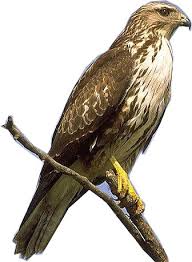 The buzzard (Buteo buteo) is a maximum of 26 years in the wild, 30 years in captivity.
The buzzard (Buteo buteo) is a maximum of 26 years in the wild, 30 years in captivity.
Its length is 46-58 cm, 110-132 cm span. The male weighs up to 700 grams, the larger females to 1,000 grams. He has long and broad wings and a relatively short, wide spread tail. The bill is black with a yellow wax on the bill base. The eyes contain eight times as much light-sensitive cells per square millimeter as ours.
The color varies from dark brown to cream. The upper part is equaly, the lower surface having various cross- ties. He has a stocky build, with a short neck.
He alternates wing beats with glide. He thrives on thermals, and can continue to hover on site (hang). In flight, the buzzard produces regularly a loud meowing cry.
Distinction from the honey buzzard: who has two bands at the base and one near the end of its tail. The buzzard has 8 to 10 lines at regular intervals. The honey buzzard has a different call with high whistling and holds in flight his wings almost horizontally. The buzzard holds the wings in the flight in a more shallow V- shape.
Buzzards are usually monogamous. A pair remains several breeding seasons together. Sometimes a male has two females.
Buzzards nest in wooded areas with clearings, fields, meadows and marshes in trees 10-20 m height. Some couples build a new nest each year, other couples use the nest several years in succession.
They lay 2 to 4, but usually three whitish eggs with more or less brown spots and smudges.
The chicks keep the nest clean. Feces they are shooting (shitting) over the edge. The further you can see them from the nest, the older the little ones are.
Often they sit along roads on a pole, looking for voles and hit bait.
They eat voles, rabbits, amphibians, reptiles, insects and worms. Occasionally poultry, mostly nestlings or young animals.
The buzzard picks his prey perched on a branch or pole. Mice and insects are also eaten on the ground.
Normally your chickens are safe from him unless they are attacked by another animal and / or slain.
